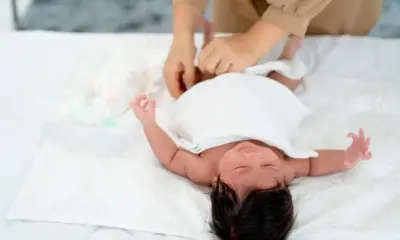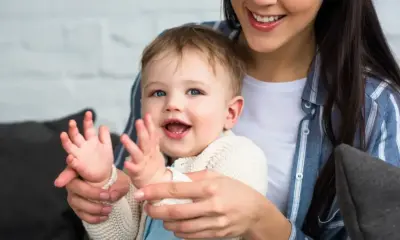Sleep
Why Do Babies Twitch in Their Sleep? Normal Behavior or Concern?
Baby Twitching During Sleep: What Every Parent Should Know
Watching your baby grow is a heartwarming experience. You cherish their smiles, coos, and peaceful sleep. However, some parents may notice small jerks or spasms while their baby sleeps. These are called twitches. Many wonder if they are normal or a cause for concern. In this guide, we explore the reasons behind these movements. We also discuss when you should seek help.
Twitching in sleep is common in newborns. It usually happens during the early sleep stages. These movements, often called sleep myoclonus, are not typically harmful. Baby Twitching During Sleep can be alarming to witness, but in most cases, it’s completely normal.
Is It Normal for Babies to Twitch While Sleeping?
Sleep twitching is frequent in babies from birth to three years. It often disappears between two to six months. Experts call this condition benign neonatal sleep myoclonus (BNSM). It refers to involuntary muscle twitches that only occur during sleep. These are usually harmless and don’t signal brain problems.
In most instances, Baby Twitching During Sleep is nothing more than a developmental phase. Studies suggest it affects about 0.8 to 3 out of every 1,000 newborns. If you notice twitching, try recording it on video. This helps doctors determine if it’s normal or a potential concern.
What Causes Twitching in Baby’s Sleep?
The exact cause of twitching is still unknown. However, research offers several possible explanations. One theory suggests a temporary serotonin imbalance. Others believe genetics may also play a role.
According to the American Academy of Pediatrics, twitching can happen during any sleep phase. These movements often stop once the baby is awake. Researchers also note that rocking or loud sounds might trigger these twitches.
Twitches can last from 10 to 20 seconds. Many of these movements occur during REM sleep. This phase plays a key role in brain and motor development. Experts believe twitching helps babies learn about their limbs and movements.
For instance, a baby may twitch their neck during sleep. This action might relate to head control when awake. Similarly, finger or toe twitches may link to crawling or grabbing objects.
When Should Parents Worry About Twitching?
While twitching during sleep is usually harmless, some signs may suggest deeper issues. The key difference lies in whether the twitches happen only during sleep. Twitching that continues while the baby is awake could be a red flag.
One study on 38 infants with BNSM found that twitches began between days 1 and 16. Most episodes lasted a few seconds to 20 minutes. They occurred only during sleep and stopped spontaneously or with arousal.
You should consult a doctor if:
- Twitching occurs while your baby is awake.
- The movements last longer than usual.
- You notice signs of developmental delay.
Let’s explore some conditions that could mimic sleep twitching but need medical attention.
Infantile Spasms
Infantile spasms are a type of epilepsy. They often appear between two and twelve months. These seizures involve sudden stiffening or jerking. The arms and legs may flex, and the head may tilt forward. They usually come in clusters every five to ten seconds.
A parent, Chris Seay, shared his experience online. His daughter, Gabby, had subtle movements while feeding. At first, they seemed minor. But after showing videos to a doctor, she was diagnosed with infantile spasms. With early treatment using ACTH injections, her spasms stopped within five days.
Benign Familial Neonatal Convulsions
This rare condition appears within the first few days after birth. It causes repeated seizures but usually stops by the time the baby is four months old. Symptoms may include full-body convulsions, trembling, and muscle stiffness. It’s more common if there’s a family history of seizures.
Febrile Seizures
These seizures occur due to high fever. Babies and young children between six months and five years are most at risk. Febrile seizures are not always dangerous but can be scary. Signs include eye-rolling, stiff limbs, and uncontrollable shaking. They may last a few minutes and usually resolve without long-term effects.
General Seizures
Seizures result from abnormal electrical activity in the brain. These can affect movement, awareness, and behavior. A baby may show signs like staring, shaking, or twitching. The National Institutes of Health estimates 80 to 120 cases per 100,000 newborns annually. Quick diagnosis and treatment are essential.
Epilepsy
Epilepsy causes repeated, unprovoked seizures. It can result from brain injury or unknown causes. Unlike benign twitching, epileptic seizures happen even when the baby is awake. Parents should consult a pediatric neurologist for proper testing and treatment.
Periodic Limb Movement Disorder (PLMD)
PLMD causes repeated leg movements during sleep. These occur every 20 to 40 seconds. Though rare in infants, babies with a parent who has restless leg syndrome may face higher risk. If your child shows rhythmic leg jerks during sleep, consult your pediatrician.
Baby Twitching During Sleep: How to Monitor and Act
If your baby twitches during sleep, stay calm. Observe the pattern. Use your phone to record the episodes. Sharing this with your doctor helps identify whether it’s a harmless twitch or a medical issue.
Remember, Baby Twitching During Sleep often points to healthy neurological development. However, if the movements seem excessive or continue when your child is awake, consult a pediatrician.
Frequently Asked Questions
Is twitching during sleep a sign of epilepsy?
Not always. Epilepsy includes frequent, unprovoked seizures. These can involve confusion, staring, or unconscious jerking. Twitching during sleep alone does not confirm epilepsy.
Is twitching a type of seizure?
It could be, but not necessarily. If twitching lasts over 20 seconds or happens when awake, seek medical evaluation to rule out seizures.
How do I tell the difference between twitching and seizures?
Twitches are short, irregular movements during sleep. Seizures are more repetitive and often happen while the baby is awake. Recording the episode helps with diagnosis.
Final Thoughts on Baby Twitching During Sleep
Twitching in babies is mostly normal and part of their brain development. These sleep movements help your baby learn body awareness. However, not every twitch is innocent. If your baby twitches when awake, or the episodes last longer than usual, talk to a doctor.
Baby Twitching During Sleep can appear scary, but it often means your baby is growing and learning. By staying informed and observing closely, you can help your baby grow up healthy and safe.

Courtesy of Mom Junction
Explore More on Baby Sleep and Health
Curious about more baby behavior and wellness topics? Explore more parenting tips and baby health updates on this website. Stay informed and support your little one every step of the way.












